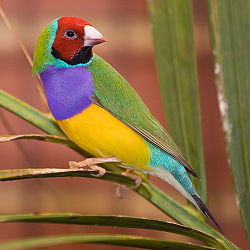Log in
PPO TIme
Top posters
| Dammam (1384) | ||||
| acruz (1049) | ||||
| zapco (915) | ||||
| dennis_go (910) | ||||
| .bygafricans. (854) | ||||
| mhyke7 (787) | ||||
| kingphilipkennel (528) | ||||
| lutinoman (519) | ||||
| blessmar (419) | ||||
| lestre (236) |
Latest topics
Search
Breeding GOULDIAN FINCHES
+3
.bygafricans.
deric
utoy
7 posters
Page 1 of 1
 Breeding GOULDIAN FINCHES
Breeding GOULDIAN FINCHES
From Wikipedia, the free encyclopedia
The Gouldian Finch, Erythrura gouldiae (or Chloebia gouldiae), also known as the Lady Gouldian Finch, Gould's Finch or Rainbow Finch , is a colourful passerine bird endemic to Australia. There is strong evidence of a continuing decline, even at the best-known site near Katherine in the Northern Territory. It is bred in captivity, but is an endangered species, with fewer than 2,500 left in the wild. It is subject to a conservation program.

Taxonomy
The Gouldian Finch was described by British ornithological artist John Gould in 1844 and named after his wife Elizabeth. It is also known in its native country as the Rainbow, Gould, or Lady Gouldian Finch (although Mrs Gould did not hold the title Lady). It is a member of the weaver-finch family Estrildidae, which is sometimes considered a subfamily of Passeridae.
Exported to Europe, the United States and Japan has provided this bird with a number of colour mutations such as the blue back, pastel, silver, yellow back and even white.
Description
Gouldian Finches are about 130–140 mm long. Both sexes are brightly coloured with black, green, yellow, red and other colours. The females tend to be less brightly coloured. This is thought to be so that they are less noticeable when sitting in a nest, while a colourful male can distract predators away from the nest, thereby ensuring the survival of the young. One major difference between the sexes is that the male's chest is purple, while the female's is a lighter mauve colour.
Gouldian Finches' heads may be red, black, or yellow. People used to think they were three different kinds of finches, but now it is known that they are just colour variations. Selective breeding has also developed mutations (blue, yellow and silver instead of green back) in body colour and breast colour.
Juveniles have distinctive colours. Their heads, sides and necks are grey, and their backs, wings and tail feathers are olive green. Their undersides are pale brown. Beaks are blackish with a reddish tip. Their legs and feet are light brown. Newly hatched Gouldian finches are pink and naked until about 12 days old when the beginnings of feathers start to appear. Very young birds also have blue, shiny structures on the sides of their beaks to help their parents see them in the dark.

Distribution and habitat
This bird is found in northern Australia: the Cape York Peninsula through north-west Queensland and the northern Northern Territory to the Kimberley region of Western Australia. Their habitat is tropical savanna woodland—open plains with tall trees—near mangroves and water. The birds apparently migrate south when it is the rainy season at the 'top end' of Australia, returning in the dry season.
Conservation status
The numbers of Gouldian Finches have decreased quite dramatically during the 20th century. Their habitat has been reduced or altered. They have also been affected by parasites called air sac mites, which have reduced their numbers drastically. In general, Gouldian Finches are susceptible to diseases and viral infections. Their beautiful colours mean that they are easily caught by predators. Fires are listed as the number-one threat to the natural populations. The total number of Gouldian finches altogether is not low, however, because they are among the most popular pet birds, and are bred in captivity for the pet trade.
Actions have been taken and are underway to implement a recovery plan to recover and conserve its natural habitats, such as building protective fencing to prevent damage by herbivores(such as rabbits). There is also detailed research on fire, food and movements at two sites to review its distribution, habitats, potential threats and conservation status of savanna granivorous birds. It was also proposed to find more suitable habitat for its conservation. Attempts at reintroduction have so far proved unsuccessful; however, they will continue a reintroduction program in eastern Queensland. It was also suggested to develop management guidelines for land-holders about appropriate land management, promoting the recovery programme and Gouldian Finches conservation.
Behaviour
Gouldian Finches are very social birds and are often found in large flocks. Flocks may consist of up to 500–1000 individuals. Pairs may even share hollows in the same tree when they are nesting. Gouldian Finches are quiet birds that generally stay away from places where people live. Their calls are not heard over great distances
Feeding
Like other finches, the Gouldian Finch is a seed eater. They prefer to feed on tall grasses rather than on the ground. For most of the year, Gouldian Finches feed mostly on ripe or half-ripe grass seeds. During the breeding season, however, the diet consists almost entirely on insects, such as beetles, termites, flies and spiders. Insects are rich in protein and help satisfy the young baby finches.
Breeding
Gouldian finches generally make their nests in holes such as termite mounds or in tree hollows. Sometimes they make nests in tall grasses. The nests are generally near water.
Gouldians bond and mate for life. In captivity mating is more elastic. They usually breed in the last part of the rainy season, when there is plenty of food around. The male courtship dance is a fascinating spectacle. When a male is courting a female, he bobs about ruffling his feathers to show off his colours. He expands his chest and fluffs out his forehead feathers. After mating, a female lays a clutch of about 4–8 eggs. Both parents help brood the eggs during the daytime, and the female stays on the eggs at night. When the eggs hatch, both parents help care for the young. Gouldian Finches leave the nest at 3 weeks of age.
Young Gouldians are very fragile until their final moult. Some breeders believe parent-raised Gouldians have greater success rearing young than those fostered by other species, such as society or spice finches. Gouldians have been known to eat their own eggs when food is scarce.
It has been shown scientifically that female finches from Northern Australia are controlling the sex of their offspring, according to the head colour of their male counterpart.
Aviculture
They need premium finch food, fresh water every day, gravel, a cuttlebone, perches, fresh fruit, vitamins (the blue-blacked ones can not produce their own vitamin A, they especially need vitamins in their water), insects (dried or alive), and maybe a few toys for entertainment. Water should be changed every day. Gravel should be replaced once a month and whole cage should be cleaned and disinfected. The Gouldian finch proves to be difficult to breed outside its native climate of Australia but does well when given the right conditions such as a large flight or avairy.
Current research has cast doubt on the need for grit (gravel) and cuttlebone in a bird's diet. Grit is now thought to have been accidentally ingested by ground feeding birds.
Many mutations occur in aviculture. Yellow, dilute, blue, silver, white and even albino gouldian finches.
The Gouldian Finch, Erythrura gouldiae (or Chloebia gouldiae), also known as the Lady Gouldian Finch, Gould's Finch or Rainbow Finch , is a colourful passerine bird endemic to Australia. There is strong evidence of a continuing decline, even at the best-known site near Katherine in the Northern Territory. It is bred in captivity, but is an endangered species, with fewer than 2,500 left in the wild. It is subject to a conservation program.

Taxonomy
The Gouldian Finch was described by British ornithological artist John Gould in 1844 and named after his wife Elizabeth. It is also known in its native country as the Rainbow, Gould, or Lady Gouldian Finch (although Mrs Gould did not hold the title Lady). It is a member of the weaver-finch family Estrildidae, which is sometimes considered a subfamily of Passeridae.
Exported to Europe, the United States and Japan has provided this bird with a number of colour mutations such as the blue back, pastel, silver, yellow back and even white.
Description
Gouldian Finches are about 130–140 mm long. Both sexes are brightly coloured with black, green, yellow, red and other colours. The females tend to be less brightly coloured. This is thought to be so that they are less noticeable when sitting in a nest, while a colourful male can distract predators away from the nest, thereby ensuring the survival of the young. One major difference between the sexes is that the male's chest is purple, while the female's is a lighter mauve colour.
Gouldian Finches' heads may be red, black, or yellow. People used to think they were three different kinds of finches, but now it is known that they are just colour variations. Selective breeding has also developed mutations (blue, yellow and silver instead of green back) in body colour and breast colour.
Juveniles have distinctive colours. Their heads, sides and necks are grey, and their backs, wings and tail feathers are olive green. Their undersides are pale brown. Beaks are blackish with a reddish tip. Their legs and feet are light brown. Newly hatched Gouldian finches are pink and naked until about 12 days old when the beginnings of feathers start to appear. Very young birds also have blue, shiny structures on the sides of their beaks to help their parents see them in the dark.

Distribution and habitat
This bird is found in northern Australia: the Cape York Peninsula through north-west Queensland and the northern Northern Territory to the Kimberley region of Western Australia. Their habitat is tropical savanna woodland—open plains with tall trees—near mangroves and water. The birds apparently migrate south when it is the rainy season at the 'top end' of Australia, returning in the dry season.
Conservation status
The numbers of Gouldian Finches have decreased quite dramatically during the 20th century. Their habitat has been reduced or altered. They have also been affected by parasites called air sac mites, which have reduced their numbers drastically. In general, Gouldian Finches are susceptible to diseases and viral infections. Their beautiful colours mean that they are easily caught by predators. Fires are listed as the number-one threat to the natural populations. The total number of Gouldian finches altogether is not low, however, because they are among the most popular pet birds, and are bred in captivity for the pet trade.
Actions have been taken and are underway to implement a recovery plan to recover and conserve its natural habitats, such as building protective fencing to prevent damage by herbivores(such as rabbits). There is also detailed research on fire, food and movements at two sites to review its distribution, habitats, potential threats and conservation status of savanna granivorous birds. It was also proposed to find more suitable habitat for its conservation. Attempts at reintroduction have so far proved unsuccessful; however, they will continue a reintroduction program in eastern Queensland. It was also suggested to develop management guidelines for land-holders about appropriate land management, promoting the recovery programme and Gouldian Finches conservation.
Behaviour
Gouldian Finches are very social birds and are often found in large flocks. Flocks may consist of up to 500–1000 individuals. Pairs may even share hollows in the same tree when they are nesting. Gouldian Finches are quiet birds that generally stay away from places where people live. Their calls are not heard over great distances
Feeding
Like other finches, the Gouldian Finch is a seed eater. They prefer to feed on tall grasses rather than on the ground. For most of the year, Gouldian Finches feed mostly on ripe or half-ripe grass seeds. During the breeding season, however, the diet consists almost entirely on insects, such as beetles, termites, flies and spiders. Insects are rich in protein and help satisfy the young baby finches.
Breeding
Gouldian finches generally make their nests in holes such as termite mounds or in tree hollows. Sometimes they make nests in tall grasses. The nests are generally near water.
Gouldians bond and mate for life. In captivity mating is more elastic. They usually breed in the last part of the rainy season, when there is plenty of food around. The male courtship dance is a fascinating spectacle. When a male is courting a female, he bobs about ruffling his feathers to show off his colours. He expands his chest and fluffs out his forehead feathers. After mating, a female lays a clutch of about 4–8 eggs. Both parents help brood the eggs during the daytime, and the female stays on the eggs at night. When the eggs hatch, both parents help care for the young. Gouldian Finches leave the nest at 3 weeks of age.
Young Gouldians are very fragile until their final moult. Some breeders believe parent-raised Gouldians have greater success rearing young than those fostered by other species, such as society or spice finches. Gouldians have been known to eat their own eggs when food is scarce.
It has been shown scientifically that female finches from Northern Australia are controlling the sex of their offspring, according to the head colour of their male counterpart.
Aviculture
They need premium finch food, fresh water every day, gravel, a cuttlebone, perches, fresh fruit, vitamins (the blue-blacked ones can not produce their own vitamin A, they especially need vitamins in their water), insects (dried or alive), and maybe a few toys for entertainment. Water should be changed every day. Gravel should be replaced once a month and whole cage should be cleaned and disinfected. The Gouldian finch proves to be difficult to breed outside its native climate of Australia but does well when given the right conditions such as a large flight or avairy.
Current research has cast doubt on the need for grit (gravel) and cuttlebone in a bird's diet. Grit is now thought to have been accidentally ingested by ground feeding birds.
Many mutations occur in aviculture. Yellow, dilute, blue, silver, white and even albino gouldian finches.

utoy- PPO 2nd Lieutenant

 Re: Breeding GOULDIAN FINCHES
Re: Breeding GOULDIAN FINCHES
good morning share ko rin po ang bigay sakin ng aking pamangkin
sabi po nila ung yellow ang male at ung purple ang breast ang female
[img][/img]
[img][/img]
mga sir, talaga po bang need na nasa loob lang sila ng bahay
maraming salamat po
sabi po nila ung yellow ang male at ung purple ang breast ang female
[img][/img]

[img][/img]

mga sir, talaga po bang need na nasa loob lang sila ng bahay
maraming salamat po
Last edited by blessmar on Mon Apr 27, 2009 6:52 pm; edited 1 time in total

blessmar- PPO Brigadier General

 Re: Breeding GOULDIAN FINCHES
Re: Breeding GOULDIAN FINCHES
at eto naman po pala ang kanilang cage
[img][/img]
muli maraming salamat po
[img][/img]

muli maraming salamat po

blessmar- PPO Brigadier General

 Re: Breeding GOULDIAN FINCHES
Re: Breeding GOULDIAN FINCHES
blessmar wrote:at eto naman po pala ang kanilang cage
[img][/img]
muli maraming salamat po
As I see, Maliit mam/sir ang nest nyo! Sa tanong nyo kung dapat sila sa labas o sa loob ng bahay, Depende po yan kung adapted ang mga gouldian na nakuha nyo sa outdoor. kung galing sa indoor wag na nyo itry na ilabas. better safe than sorry.

jumbodavid- PPO Private

 Re: Breeding GOULDIAN FINCHES
Re: Breeding GOULDIAN FINCHES
ano po ang possible na anak ng pair na yellowback hen at blueback cock?

jo2xo- PPO Private

 Re: Breeding GOULDIAN FINCHES
Re: Breeding GOULDIAN FINCHES
jo2xo wrote:ano po ang possible na anak ng pair na yellowback hen at blueback cock?
kung normal ang yellowback mo(walang karga) ang mga lalabas ay Dilute,Yellow and Green.
kung split ang yellowback mo (kargado) ang mga lalabas ay Dilute,Pastel,silver,yellow,Green and Blue.


jumbodavid- PPO Private

 Similar topics
Similar topics» Zebra finch, Star finch, shaftail finch Fancier etc.....
» Breeding CANARIES
» BREEDING CONURES
» PHEASANT BREEDING
» Breeding and Identifying: Budgies and Parakeets
» Breeding CANARIES
» BREEDING CONURES
» PHEASANT BREEDING
» Breeding and Identifying: Budgies and Parakeets
Page 1 of 1
Permissions in this forum:
You cannot reply to topics in this forum













» Dynamically move your LCD on wall like this
» WHO MUST WE BLAME?
» LETS COUNT IN ENGLISH WORDS
» ENJOY THE COFFEE
» what should i do for my wall mount fireplace lcd
» what should i prepare for my home?
» INTERVIEW THE NEXT PERSON
» Want your feedback about fireplace LCD
» PARES PARES
» Mag sign in tayo dito
» Best Borwser